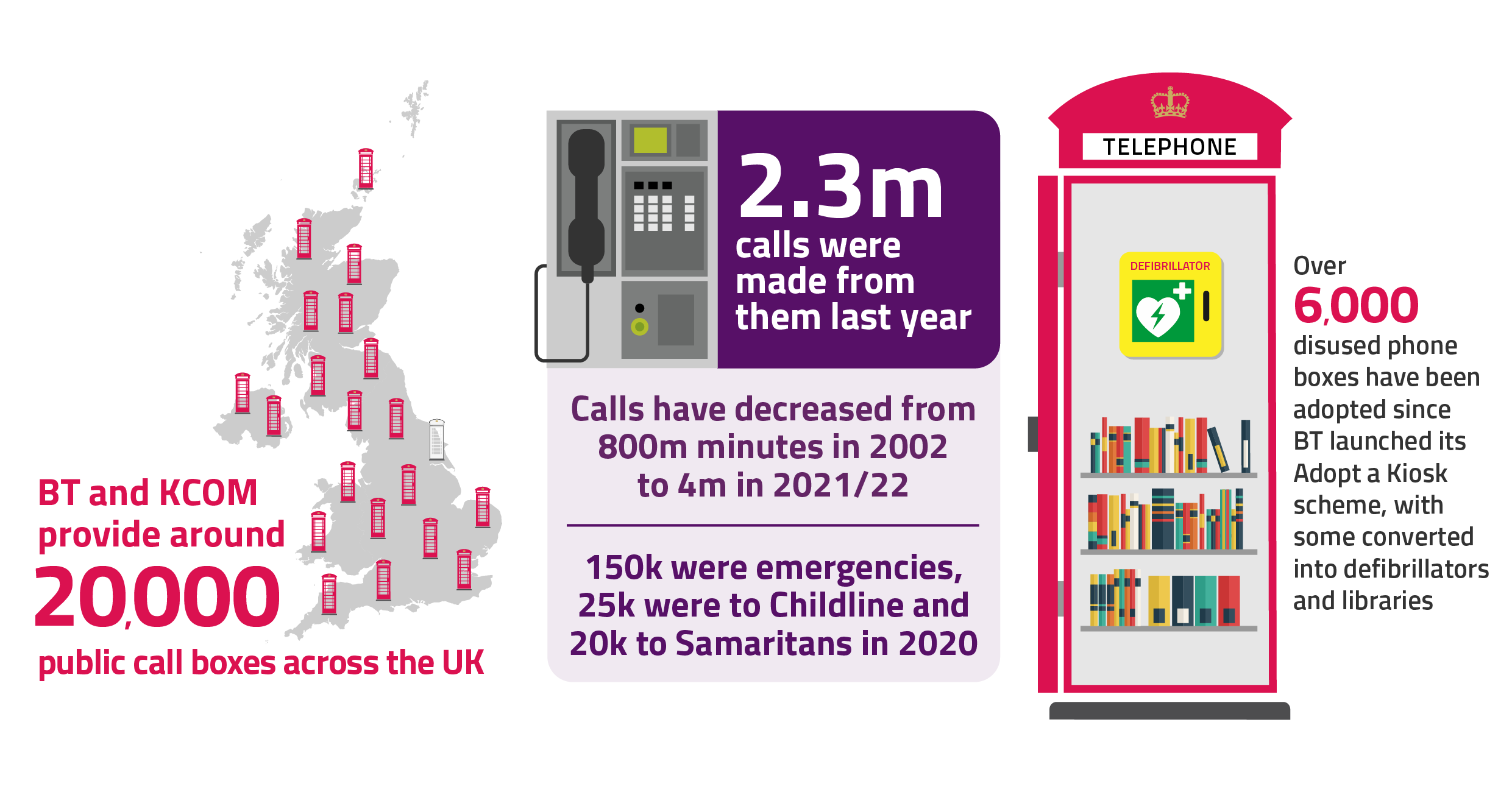
- Payphones in areas with poor mobile signal or high accident rates protected from today
- Rules also updated to support on-street ‘hubs’ offering free calls, Wi-Fi and charging on the go
Stronger protections for public call boxes come into force today, under new rules announced by Ofcom.
The changes mean that, from today, phone boxes will be safeguarded against removal if they are still needed by a local community.
Although there has been a steep decline in calls made from phone boxes, from around 800m minutes in 2002 to 4m in 2021/22, they continue to provide an essential service in some areas, such as locations without full mobile signal.
And almost 150,000 calls were made to emergency services from phone boxes in the year to May 2020. Some 25,000 calls were made to Childline, and 20,000 to Samaritans.
Protecting phone boxes still needed by communities
Under Ofcom’s new criteria, phone boxes will now be protected where:
- they are in a place without coverage from all four mobile network providers; or
- they are located in an area with a high frequency of accidents or suicides; or
- 52 or more calls have been made from them over the past 12 months; or
- there is other evidence that a phone box is reasonably needed at a site – for example, where it is being used to make calls to helplines such as Childline
The rules replace the previous process for removing payphones, which risked removal in locations where they were still required.
We previously estimated that around 5,000 phone boxes would be covered by these protections. Given the ongoing decline in call volumes and improvements to mobile coverage we expect some of these may no longer require protection, although our more recent mobile coverage data indicates that at least 1,400 boxes still do not have good mobile coverage.
BT (and KCOM, the operator in Hull) must also still consult with local authorities on the removal of boxes that are the last remaining in an area.
Adapting to new ways of communicating
The protections have been updated to reflect the changes to the way that people are making calls. 96% of UK adults now own a mobile phone, and mobile coverage has improved significantly in recent years.
Over the next few years, mobile coverage will continue to develop as a result of the Shared Rural Network Scheme, a joint initiative between government and industry to increase 4G coverage across the UK. The move to digital phone lines will also require investment to upgrade phone boxes, including the installation of batteries, so they can still be used during a power cut.
As a result, Ofcom is providing greater flexibility for the removal of phone boxes that are no longer needed, as BT rolls out a new generation of street hubs that offer services such as free Wi-Fi and free charging.
You may think of a phone box as a local landmark, or as a landmark symbol of British nostalgia. But they can still serve as a vital lifeline – perhaps to call a helpline or the emergency services – when no other options are available.
Our new rules will ensure that many thousands of phone boxes will be protected for as long as they are needed, as well as supporting the rollout of new street hubs, with free Wi-Fi and charging for people on the go.
Selina Chadha Ofcom’s Director of Connectivity
Evolution of the public call box

Notes to editors
- Other evidence of reasonable user need: This category could include the types of calls made from the phone, such as to helpline numbers, or situations where a phone box has been relied upon during a local emergency, such as flooding.
- For several years, BT has been decommissioning payphones that it has assessed are no longer needed. However, local authorities who want to retain the iconic red kiosk can use BT’s ‘Adopt a Kiosk’ scheme. Under the scheme, local bodies can purchase a red kiosk for £1 and use it for something else. Since BT launched the scheme, more than 6,000 kiosks have been converted to a range of different uses, such as community libraries, or to house life-saving public defibrillators.
